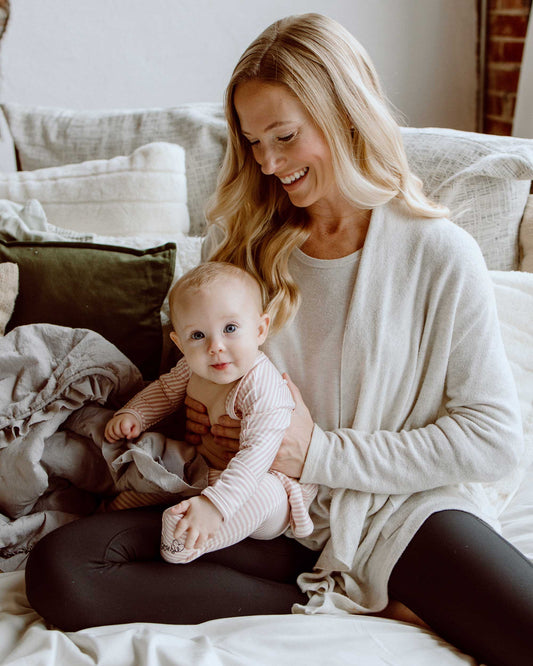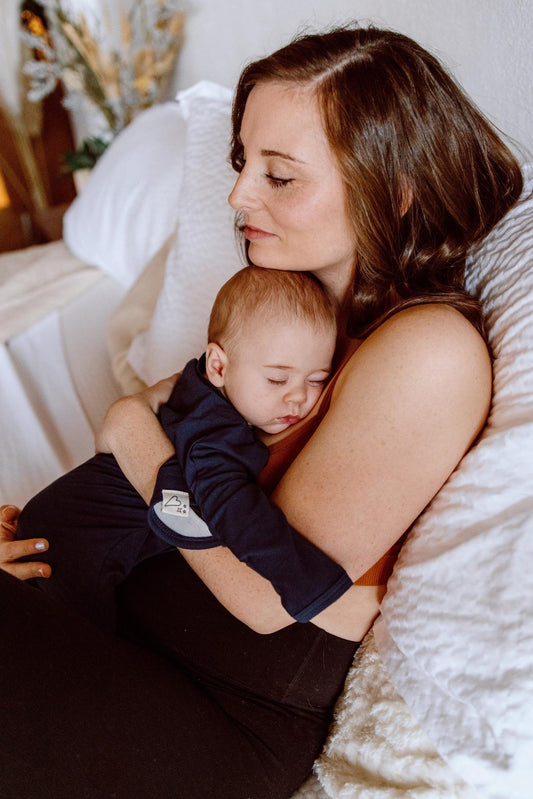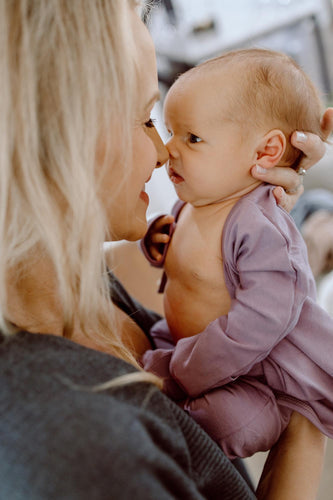Share
Prematurity Awareness Month: Quincey’s Story
Rohini MoreQuincey Carroll, mother of two, photographer, and occupational therapist started having labor contractions at 32 weeks pregnant. She was sent home with medication and put on bedrest.

Quincey and August in the NICU
For the next two weeks Quincey experienced painful contractions roughly every five minutes. She went to triage five different times, was admitted again for monitoring and to be put on an IV, and then sent back home. Finally, when the pain was so bad she couldn’t sleep or stand, she was admitted back into the hospital.
“No one could tell me what was going on, why this was happening, or help me manage it. I finally went in to be admitted because I couldn’t sleep; I couldn’t even stand. I was so sore from constant pain and mentally and physically so drained.”
Once admitted, she was told she was dilated to four centimeters, then her water broke, and soon after August was born.
“As soon as they told me I was dilated to a 4 and having him that day I was relieved because I knew the contractions and pain would finally stop, and then guilty I felt relieved because I knew he would have a NICU stay.”
August stayed in the NICU for 17 days. Quincey and her husband, Max, also have a two-year-old toddler, Brooks. While Quincey loved every moment of holding August in the NICU, she was ready to bring him home to meet her first son.

August in the NICU with his Dad, Max
“There were times that the snuggles with August were amazing, but I always wished I was home or had that experience of bringing Brooks to the hospital to meet his brother I always dreamed of…or that I was packing him up into the car and leaving like all the other moms I saw exit the hospital while I was walking in to VISIT my baby.”
During August’s NICU stay, only Quincey and Max were allowed to see August. The NICU can be a very lonely place, as so many other NICU moms have experienced.
“Max was still working so he could have paternity leave when August got home, so I was in the NICU by myself most of the time. It was so isolating. It felt like a world that I made up because when I left no one else knew him, met him, and only saw pictures or if I had the energy to FaceTime.”
One of the biggest challenges for Quincey was the emotional toll of splitting her time between her young sons while they both needed her and wanted her full attention.
“Taking care of Brooks is part of the NICU stay that had me most emotional because he needed me so badly. He would beg for time or any attention, so he started having behavioral regressions. After I would put him down for a nap he would cry and chase me out the door, begging me to stay with him and cuddle, which literally killed me.”
While August was in the NICU both Quincey and Max regularly practiced skin-to-skin contact to bond with their newborn.

Max and August practice skin-to-skin contact in the NICU
According to Sanford Health, “in NICU, a baby has more stress and emotional needs. Ongoing tests, noises and procedures are very different from the quiet, warm womb the baby has known. Being able to hold these babies skin-to-skin – even with monitors attached and/or equipment attached to them – still has been shown to help them relax and be more content.”
“Skin to skin was definitely bonding; I wasn’t able to breastfeed for a while and had to pump, but at least I got to have that,” Quincey said.
As an occupational therapist, Quincey has a lot of experience taking care of babies.
“Working in a children’s hospital I had imagined what it would be like to be that mom that has a baby in the NICU. I always thought since I had this work experience I would feel like I could manage, but it was so much harder than I ever thought. Worrying constantly if he’s going to be ok when I’m not there, physically healing myself, waking up every couple hours to pump with the empty bassinet by your bedside, feeling guilty no matter where I was. If I was in the NICU I wasn’t with Brooks who was clearly struggling, and if I was with Brooks or trying to get some rest at home was I a bad mom leaving my baby there alone? I respect all the moms that make it look easy because it’s one of the hardest things I’ve ever gone through.”

The Carroll family pose for a holiday photo
We are happy to report that August is now home with his loving family. Brooks is thrilled to have his baby brother home and Max and Quincey are soaking up each new memory with their sons.
During the month of November Bonsie Skin-to-Skin Babywear is donating 1% of every sale to an organization that works tirelessly to reduce premature births and improve infant and maternal health outcomes. Bonsie clothing is created specifically for skin-to-skin contact. Skin-to-skin contact is essential for the healthy development of premature babies because it regulates their temperature, heart rate and breathing patterns. It also releases oxytocin, a hormone that improves breastfeeding success and leads to greater weight gain and attachment to the primary caregiver. The promotion and education of skin-to-skin contact can save lives, starting with the 380,000 babies born prematurely each year.
Follow Quincey on Instagram @quinceycarrollphotography to see more photos of her beautiful family and to learn more about her photography business.
Sources:
Seitz, J. (2017, July 18). The Importance of Skin-to-Skin with Baby After Delivery. Sanford Health News. https://news.sanfordhealth.org/childrens/the-importance-of-skin-to-skin-after-delivery-you-should-know/
Share
-
Category:
- All posts




